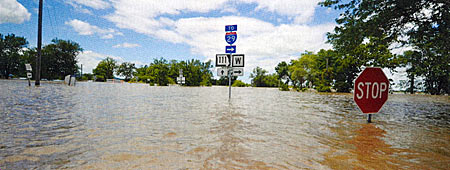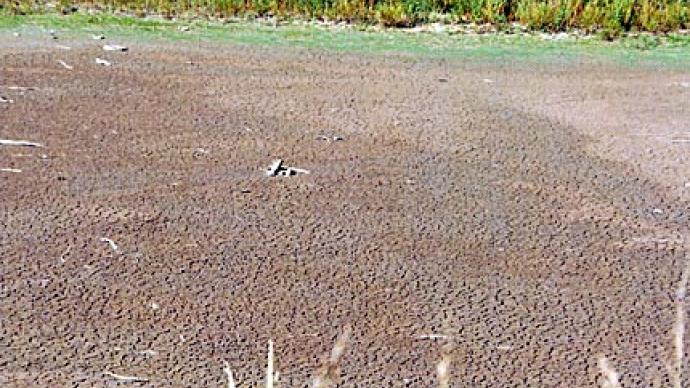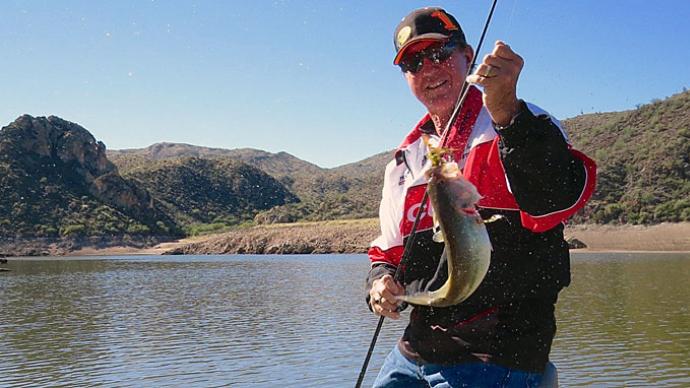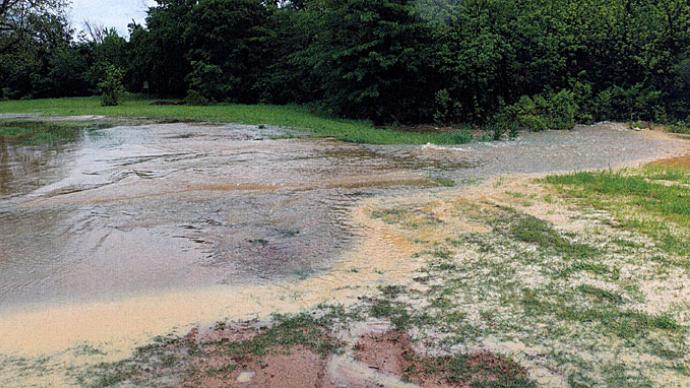
It's reported an estimated 37 trillion gallons of rain was dumped on Houston to Beaumont from Hurricane Harvey. That's an incomprehensible volume of water. Here some perspective: That's enough water to supply every United States citizen with 3,000 gallons per month—for more than 3 years. It's enough to supply the entire estimated human population of the world today (7.44 billion) almost 5,000 gallons per person. That's 8 inches of water—over the entire state of Texas. That's just what was dumped on Houston.
But alas, what the Gulf of Mexico giveth, it also taketh away. Most of that water headed back to its source, rather than be deposited for some useful purpose for humanity.
That volume doesn't count the rest of the rainfall up and down the Texas coast, nor does it account for massive rains resulting from Hurricane Irma that blasted Florida and moved north.
In its flow, Harvey's waters dissolved much. In its wake, it deposited much. That's what major floods do. The area's bigger public lakes, such as Lake Conroe and Lake Houston, flushed and received more than a fair amount of sediment. That's what happens during a major flood, whether it's around your house or the Greater Houston Metropolitan Area.
The San Jacinto River was scoured, changing its bottom and its ecology for generations (or until the next massive flood). That's what nature does, especially in these abnormal events. Big floods scour creeks, tributaries, and rivers, rearranging the bottom soils, shoving sediment downstream, and in some cases, moving rocks bigger than a pickup truck.
Hundreds, probably more like thousands, of flooded small ponds and lakes, both public and private, gave and received. With days of water sitting or moving across a pond changes are inevitable. Fish migrate out as others migrate in. Water chemistry and its biology also changed. Water dissolves anything it can. That's why scientists call it the universal solvent. As those trillions of gallons of water moved over its heretofore uncharted courses, it picked up everything from cars to trees to whatever was laying in that yard or that pasture. It dissolved parts of grass clippings, minerals, cow manure, paper, raw sewage—whatever it rolled across that was agreeable to dissolving.
For this area of Texas, it's their third 500-year flood in the last two and a half years. By definition, a 500-year flood is an event that has 1 in 500 chances of occurring in any given year. Some scientists have been quoted that the Houston/Beaumont event is a 1,000-year flood, but there's no real records to prove that. NOAA is working on the statistics to back the claim, but have enough evidence to believe this truly was a 1 in 1,000 chance.
But, I've even heard several professional meteorologists and newscasters describe the Houston event as one of "Biblical proportions".
Your bottom line is this: wherever we live, there is 1 in 500 chances to have a rainfall event with such catastrophic flooding. But, that flood in Las Vegas won't be the same as one in Tulsa. Geography and geology determine what actually defines the volume of water in such an event. A 100 year flood in Las Vegas is 3-4", while one in Tulsa is 10-12", and for Houston, it's 16-18"... over four days in each area.
Next, after the floods recede and ponds settle down, people deal with E. coli, mosquitos, and those other newsworthy pests that affect daily life in the aftermath of such an event. The good news is that water also strives to cleanse itself. Much organic matter will break down to its fundamental parts and nature will put it to use. That manure and other organic matter composts under water, releasing its elements to feed aquatic life, especially plankton and plants. Those plants and plankton become food and harbor for tiny insects, which feed bigger bugs and small fish as it moves its productive self toward the top of the food chain. That's the magic of water. From an organic mess, it can turn itself healthy, given enough sunlight and air. The thousands of flooded private ponds and lakes will do that.
That doesn't mean we sit back and wait after such a flood. If your flooded pond, or your neighbor's, sits next to a toxic industrial site, plan to test that water. If it sits next to a pasture, you're likely fine. If you're concerned, test.
Expect the fishery of smaller bodies of water to be affected. With a normal rain, fish don't leave the safe confines they consider home. But, when five-plus feet of angry, muddy flood water rolls or sits atop a pond, some fish will come, and some will go. There's the rub. That creek a mile away that flows into the river created a perfect opportunity for every river species to muddle their way into your waters. That likely means carp, gar, buffalo, gizzard shad, and a variety of other species could very well refer to your pond as their new home.
Managed ponds need to be analyzed to figure out the extent of change. Assess, then decide if, when, and what to do to make a positive change. Sure, a fishery will adjust. That's nature's way. But, it likely won't adjust as you'd like it. Being proactive and figuring out water quality and assessing the fishery will lead to solid decisions that will help your favorite fishing hole recover.
During a flood, our main concern is safety. When waters recede, people assess the damage and then decide what to do. For most folks, their ponds are way down on the list of concerns.
Keep this in mind—with such a tremendous volume of water comes tremendous change. City fathers and the citizens of Houston are holding proverbial hands with humanity as people come together to overcome what that monster Harvey left in his wake. Area-wide, ponds and lakes were affected, too. As conservationists and stewards of your own land and water, you can think about ways to steer those valuable nearby waterways to a healthy future.
Once things settle, and you are ready to spend some time and effort on your flooded pond or lake, here's a checklist of what to do:
- Analyze the water. That's Job One. A basic test, depending on the lab you choose to use, checks for pH, alkalinity, hardness, and some basic metals and minerals. If you suspect something more than those basics have changed, you'll need to decide what to test for specifically. In this case, a consultant may need to offer some thought and input. When you receive the results, seek help to interpret what it means based on your goals for that pond.
- Pay attention to different plants that may begin to grow. If you see some strange plant that wasn't there before, identify it. There are two very helpful websites to identify plants. The first is Texas A&M's site: https://aquaplant.tamu.edu/ that is excellent, as is this one from the University of Florida: https://plant-directory.ifas.ufl.edu/plant-directory/. Once you identify the new plants, learn about them and decide on an action plan.
- Watch your water color. Odds are, immediately after the flood your pond looks like chocolate milk. In years past, your water may have settled. This time, it may not. Watch the color change. If it doesn't shift into a color you think is healthy, ask for help from your fisheries specialist.
- Evaluate your fishery. Odds are high that your fish population has changed. If you are a DIYer, then go fishing and compare before and after notes. Have a sense of urgency to evaluate the fishery—because if you don't, and there's been an exodus of fish you like, and a migration of fish you don't want, your population balance will quickly shift once those fish begin to spawn next spring. When that happens, it won't be easy to unpickle that pickle. You need a reference point before next spring to be able to make wise decisions about what to do with your fishery. In the case of a major flood, I'd lean toward working with a professional private fisheries biologist. I know it's expensive, but odds are good you can put together a group of neighbors or others with similar needs and work with that pro to make it affordable for everyone. I'd sure ask.
- Last, but not least, after your water chemistry is figured out, you've identified plants and water color, and your fishery has been evaluated, revisit your management strategy. If you need to remove fish, get it done. If you have so many unwanted fish that renovation is necessary, get it handled. If you've fared well and just need to do some corrective fish stocking, do that during the cool months, and then get your management strategy back in good order.
I know floods the magnitude of Houston, Beaumont, and southern Louisiana are tragic, heartbreaking, and catastrophic. My heart melts with empathy for those folks impacted. I almost write this article with a sense of guilt, thinking about ponds in the aftermath of such an event.
But, that's what we do. Our job is to help you be a better steward of your land and water. Together, we go through floods, and droughts, and any other natural phenomenon venturing our way.
Besides, our waterways bring peace and joy. They bring memories of grandkids catching their first fish. The serenity of being around our very own puddle—whether it's in the middle of a pasture or nestled in a meadow next to the woods—just seems to sooth our souls.
That's my prayer for those who suffered unimaginable losses through these unthinkable floods.
Reprinted with permission from Pond Boss Magazine



